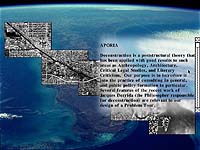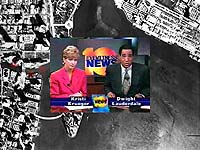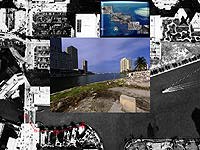
John Craig Freeman is an artist and educator exploring practices that challenge the function of art and the role of the artist. He has a substantial background in public art working with monumental sequential computer generated image/text roadside installations. These site specific works sometime span miles of highway and individual images have been as large as 400 square feet. Freeman appropriates the strategies of mass media in order to explore the power and impact of new technology used in service of individual artistic expression. Over the last several years, as the internet has developed the potential of supporting an alternative cultural discourse and audience for new and experimental art practices, Freeman has turned his attention to photographic virtual reality and interactive hyper-media in an attempt to invent new forms of art for an information technological cultural paradigm. Recognizing the need for interdisciplinary expertise, Freeman has adopted strategies of collaboration. The most recent work draws on the expertise of cultural theorists, architects and documentarians. Although he focuses on exhibiting his work in alternative public venues, Freeman has also exhibited in important galleries and museums nationally and internationally including Ambrosino Gallery in Miami, The Friends of Photography at The Ansel Adams Center in San Francisco and The Photographers Gallery in London. Freeman is a recipient of a National Endowment for the Arts Individual Artist Fellowship (1992). His work has been published in Artforum, Ten-8, Z Magazine, In These Times, Afterimage, Photo Metro, New Art Examiner, Time, Harper's, Der Spiegel and Buzzworm. Lucy Lippard cites Freeman's work in her book 'The Lure of the Local' as does Margot Lovejoy in her book 'Postmodern Currents'. Freeman is an Assistant Professor in the School of Art and Art History at the University of Florida where he teaches digital technology in the Creative Photography Area. He is active in the College Art Association, the Southeastern College Art Conference and he serves on the national board of directors of the Society for Photographic Education. He received a Bachelor of Art degree from the University of California, San Diego in 1986 and a Master of Fine Arts degree from the University of Colorado, Boulder in 1990.
Conceptual Discription:
Virtual Florida questions the opposition between pure and applied research by means of a virtual tourism. Virtual tourism adopts the tourist attraction as an interface metaphor to bring a postliterate audience into relation with an arts experience in a practical context. Like any interface metaphor, tourism is something already familiar to the potential users, that will help guide their encounter with something less familiar or even unknown to them. Some of the places most attractive to tourists are places associated with problems, trouble, or even disaster; places such as the sewers of Paris, the red-light districts of various metropolises, battlefields, or famous crime scenes (to name only a few examples) are popular with visitors, complete with a live or recorded commentary explaining how the place works or what happened there. A recent example of this phenomenon is the "Cunanan Trail Guide Maps", which sprang up in Miami the day after the Versace murder. "Tourism" as a problem (a set of interlocking problems) includes this property of Florida as attractive not only to tourists, but also to retirees, immigrants, the homeless, drug dealers, unemployed workers, serial killers. Carl Hiaasen titled his column dealing with Andrew Cunanan, "Florida: A real slime magnet." What is the attraction of Florida? In studying this question I hope that what Eisenstein did for cinema (inventing a language for the new medium of his day) I might be able to do for interactive hypermedia an the era of postliteracy.
http://www.arts.ufl.edu/art/creative_photography/freeman.html

